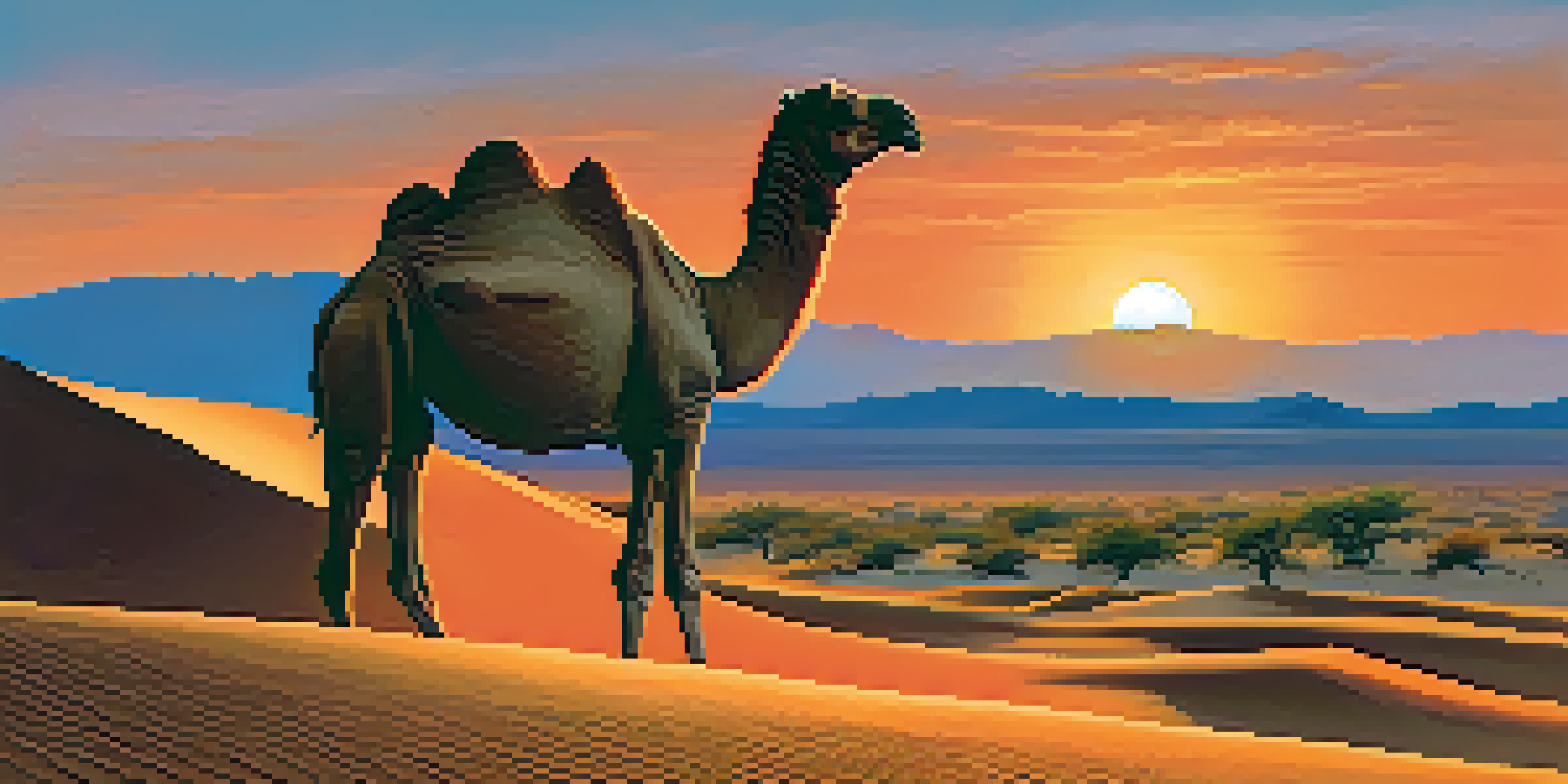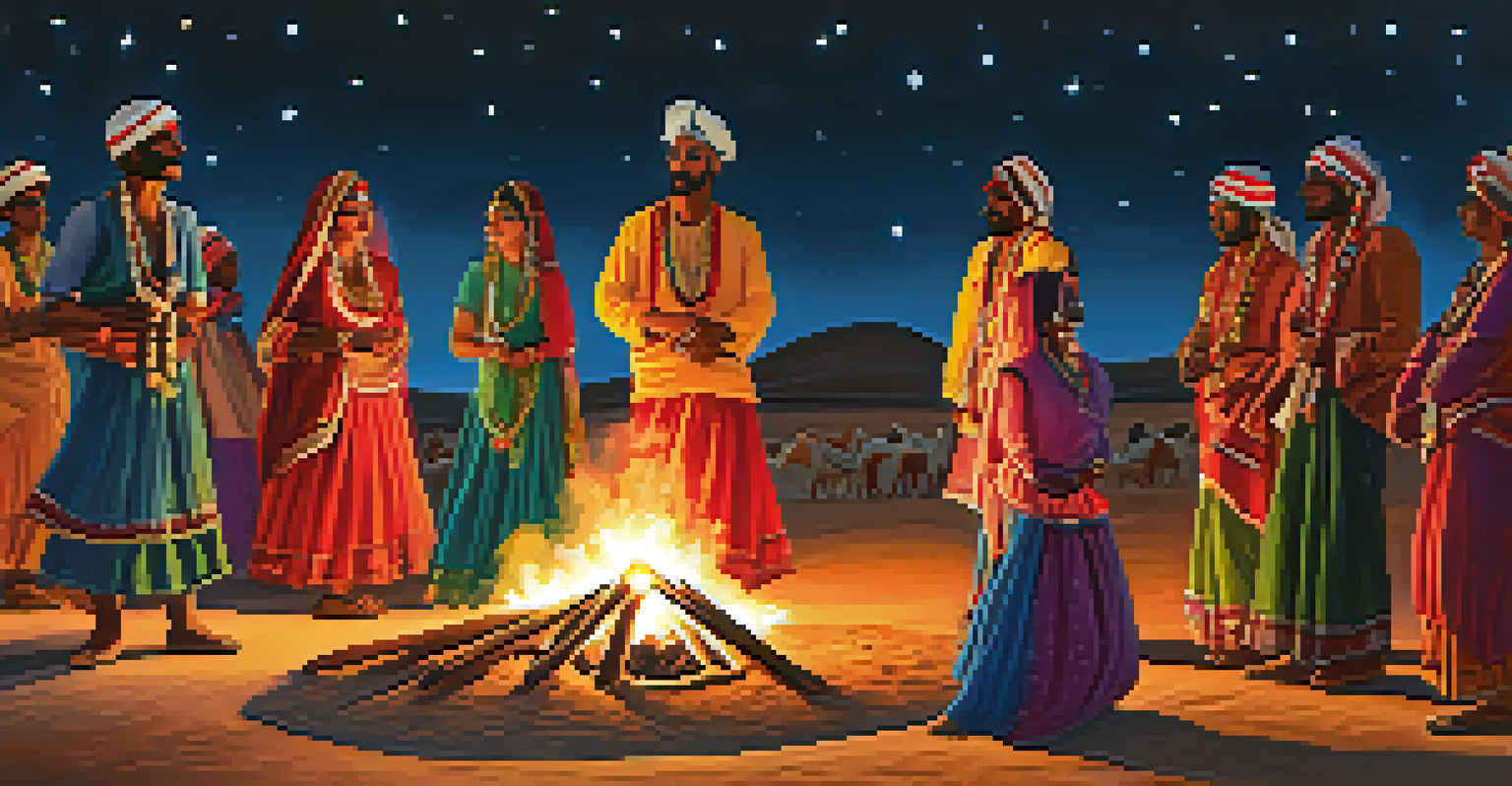The Enchanting Sand Dunes of Thar Desert in Rajasthan

Introduction to the Thar Desert: A Natural Wonder
The Thar Desert, also known as the Great Indian Desert, spans over 200,000 square kilometers, primarily in Rajasthan. This vast expanse of golden sand dunes is not just a geographical marvel; it's a tapestry of life, culture, and history. Imagine rolling hills of sand, shifting gracefully with the wind, creating a mesmerizing dance that changes daily.
The desert is a natural extension of our imagination, and the sands of time keep shifting our dreams.
Rich in biodiversity, the Thar Desert is home to unique flora and fauna, some of which are found nowhere else on Earth. From resilient desert plants like the khejri tree to elusive wildlife such as the Indian gazelle, the ecosystem here thrives against all odds. This juxtaposition of harshness and beauty is what makes the Thar truly enchanting.
As you venture into this desert, you’ll quickly realize that it’s not just about the sand. The Thar Desert encapsulates a way of life, with its vibrant culture and traditions deeply rooted in its landscape. Every grain of sand tells a story, and every dune holds a secret waiting to be uncovered.
The Majestic Sand Dunes: Nature's Sculptures
The sand dunes of the Thar Desert are a sight to behold, often reaching heights of up to 150 meters. These towering formations, shaped by the relentless winds, create a stunning visual contrast against the clear blue sky. Walking through them feels like stepping into a surreal painting, where each dune is a brushstroke of nature's artistry.

The colors of the dunes change throughout the day. At sunrise, they glow with soft golden hues, while during sunset, they take on deeper shades of orange and red, creating a breathtaking landscape. This vibrant display is a photographer's dream, offering countless opportunities to capture the beauty of nature in its rawest form.
Thar Desert: A Cultural Tapestry
The Thar Desert is not only a stunning natural landscape but also a vibrant hub of diverse cultures and traditions.
Moreover, the dunes are not just a pretty face; they also play a crucial role in the local ecosystem. They help in retaining moisture and provide a habitat for various species, proving that even in an arid environment, life finds a way to thrive. Exploring these dunes offers a deeper understanding of nature’s resilience.
Cultural Richness: Life in the Thar Desert
Beyond the stunning landscapes, the Thar Desert is a melting pot of cultures and traditions. The desert is home to various communities, including the Rajputs, Bishnois, and Jats, each with their unique customs and stories. Their vibrant clothing, music, and dance styles reflect the rich heritage that is intertwined with the desert's sandy expanses.
In every walk with nature one receives far more than he seeks.
Local festivals, like the Desert Festival in Jaisalmer, celebrate this cultural diversity. Visitors can witness traditional folk dances, camel races, and even turban-tying competitions, immersing themselves in the local way of life. These events not only provide entertainment but also foster a sense of community and pride among the residents.
Moreover, the local cuisine is an adventure for the taste buds. Dishes such as dal baati churma and gatte ki sabzi are staples that showcase the flavors of Rajasthan. Sharing a meal with the locals is an intimate way to connect with their culture, making your visit to the Thar Desert even more memorable.
Adventure Awaits: Activities in the Thar Desert
If you're an adventure seeker, the Thar Desert offers a plethora of activities to get your adrenaline pumping. From camel safaris that let you explore the dunes at a leisurely pace to thrilling dune bashing in 4x4 vehicles, there's something for everyone. The thrill of riding over the sandy hills, feeling the wind in your hair, is an experience you won't forget.
For those who enjoy a more tranquil experience, stargazing in the desert is a must. With minimal light pollution, the night sky reveals a breathtaking tapestry of stars. Laying on the cool sand, you can lose yourself in the vastness of the universe, marveling at constellations that have guided travelers for centuries.
Adventure Awaits in the Desert
From camel safaris to stargazing, the Thar Desert offers a variety of exhilarating activities for adventure seekers.
Additionally, you can participate in desert camping, where you spend the night under the stars, surrounded by the soothing sounds of the desert. Sharing stories around a campfire while listening to traditional folk songs creates a magical atmosphere that truly brings the Thar Desert to life.
Flora and Fauna: The Desert's Hidden Gems
While the Thar Desert may seem barren at first glance, it is teeming with life. The flora is uniquely adapted to survive in such arid conditions, with plants like the desert rose and various cacti showcasing nature's ingenuity. These plants not only provide shelter for wildlife but also offer a glimpse into the resilience of life in extreme environments.
Wildlife enthusiasts will be thrilled to discover the diverse animal species that call the Thar home. From the majestic blackbuck to the elusive desert fox, the desert is a sanctuary for many animals. Birdwatchers, in particular, will delight in spotting migratory birds that visit the wetlands during certain seasons, making the desert an unexpected avian haven.
Exploring the flora and fauna of the Thar Desert can be an enlightening experience. Guided nature walks provide insights into the delicate balance of the ecosystem, illustrating how each species plays a vital role in sustaining life. Understanding this interconnectedness enhances your appreciation for the desert's beauty.
Preserving the Thar: Environmental Challenges
Despite its enchanting allure, the Thar Desert faces several environmental challenges, primarily due to climate change and human activity. The increasing temperatures and erratic rainfall patterns threaten the delicate ecosystem, putting pressure on the flora and fauna that thrive in this harsh environment. It’s a stark reminder of how interconnected we are with the natural world.
Overgrazing by livestock and urban expansion also pose significant threats. These factors lead to land degradation, impacting not only the wildlife but also the livelihoods of the local communities who depend on the desert's resources. Sustainable practices are crucial to ensure that this beautiful landscape continues to thrive for generations to come.
Environmental Challenges Persist
The Thar Desert faces significant environmental threats from climate change and human activity, necessitating sustainable practices for preservation.
Efforts are being made to address these challenges through conservation initiatives. Local communities and organizations are working together to promote sustainable tourism and responsible practices. By raising awareness and involving residents in conservation efforts, there's hope for a brighter future for the Thar Desert.
Planning Your Visit: Tips for Travelers
If you're planning a trip to the Thar Desert, timing is everything. The best time to visit is between October and March when the weather is pleasantly cool, perfect for exploring. During this period, the desert comes alive with various festivals, making your experience even more vibrant and memorable.
When packing, consider lightweight, breathable clothing to stay comfortable during the day, and warmer layers for the chilly desert nights. Don't forget essentials like sunscreen, a hat, and plenty of water to keep hydrated. A good pair of walking shoes is also crucial for traversing the sandy terrain.

Finally, embrace the local culture during your visit. Interact with the residents, try traditional dishes, and participate in local activities. By engaging with the community, you'll not only enrich your experience but also leave with cherished memories of the enchanting Thar Desert.